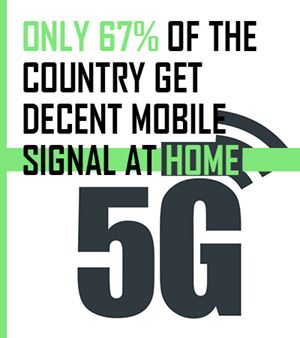Joining the 5G Communications Revolution
The dawning of a new 5G broadband technology era is upon us. And, if you believe the hype, the improved mobile network connection, faster and more reliable data transfer and better download speed that it promises to bring are set to transform lives, businesses and communities, and the nation’s economic growth.
As the backbone of a new breed of digital industry and services, the 5G revolution is certainly drawing both attention and infrastructure investments. While the headlines might be focused on the ability to download movies in seconds, 5G’s real power is to underpin rising tech stars such as the Internet of Things, artificial intelligence, autonomous vehicles and augmented reality.
The UK government is keen to ensure that it becomes mainstream and makes it beyond the urban centres. As part of £200m investment nationally, the government has recently launched a £30m competition, designed to test ground-breaking 5G coverage in rural areas.
In October last year, it also published its 5G testbeds and trials programme, a cross-government activity map to highlight government initiatives encouraging investment in 5G.
What are the challenges with rural broadband?
The communications challenge has multiple fronts. High speed broadband remains very poor for large parts of the countryside, with investment to deliver 4G coverage and fixed fibre still commercially unjustified. The recent general election saw this become a political issue, with the Conservatives stating an intention to roll out gigabit broadband across the UK by 2025, alongside greater mobile coverage, and pledging £5 billion to make this happen.
On the face of it, 5G technology, with its ability to offer fibre speed over the air, should obviate the need for fibre by providing localised, high-capacity 5G clusters.

Thus, whilst the additional provision of infrastructure needed for 5G – urban and rural – will see a shift from a reliance on larger “macrocell” sites to a dense network of small cells, particularly in urban areas, most sites will be connected to a “backhaul” network by fibre.
Unsurprisingly, for all the excitement, telecoms providers aren’t rushing to invest. The technology roll-out is complex and expensive, and the business case so far – consumers being willing to pay more – doesn’t stack up. For most of us, 4G is enough to check our social media; fibre sorts out Netflix. In the current market-driven scenario, 5G risks becoming a service for city-dwellers.
All of which means that, while just 67% of the country get decent mobile signal at home and poor data speeds in rural areas remain an economy-dragging problem, current 5G thinking is unlikely to hold the answer.
Hence the UK government’s £30m stimulus, through which ten rural locations will trial 5G applications and “stimulate commercial investment.”
“The British countryside has always been a hotbed of pioneering industries and we’re making sure our rural communities aren’t left behind in the digital age,” said Digital Secretary Nicky Morgan, launching the competition. “People expect to be connected wherever they are. And so we’re committed to securing widespread mobile coverage and must make sure we have the right planning laws to give the UK the best infrastructure to stay ahead.”
What else is affecting 5g technologies in rural areas?
The reforms to the Electronic Communications Code (ECC) in December 2017 has also hindered progress, having effectively caused landowners to withdraw from the market; not ideal at a time when many existing site agreements are expiring, and operators need to expand rights and deploy new installations for 5G rollout.
A fundamental change in the basis of valuation for telecoms sites – effectively the site’s value to the landowner, rather than the operator (a ‘no network’ assumption) – is hitting rural landowners the hardest. Such sites would have typically generated £5-6,000 annually; today opening offers from operators are in the hundreds or even tens of pounds.
Although the ECC gives operators greater statutory powers and the ability to apply to the courts for an agreement to be imposed, there is only limited capacity in the legal system. There are thought to be over 70 cases stuck in the system, pending a decision.
Even a decision from the Upper Tribunal seems to have little impact in giving certainty or direction to the market, with key precedent cases heading to appeal; Cornerstone Telecommunications Infrastructure Ltd v Ashloch Ltd & Anor 2019 being the most recent and having the effect of halting many negotiations pending the outcome.
The government also promised to reform planning laws to make it easier for telecoms firms to build out rural telephone and fibre networks. The ongoing consultation on potential changes to permitted development rights includes proposals on:
- changing the permitted height of new masts
- allowing existing ground-based masts to be strengthened without prior approval
- deploying radio equipment cabinets without prior approval
- allowing building-based masts nearer to roads to support 5G and increase mobile coverage.
Such simplification of the planning rules for installing new mobile technology will, the UK government hopes, encourage private investment into rural infrastructure, helping banish blackspots for those living in rural areas and accelerating the rural 5G revolution.
It may well do. Yet, irrespective of any planning rule relaxation or, for that matter, any government funding to sweeten the deals, it is likely that these changes in land valuation will have a major impact on the speed of 5G rollout.
Paul Williams is a Telecommunications specialist at Carter Jonas.
What is 5G and why is it better than 4G?
5G represents a major change over previous generations and enables applications and opportunities impossible under 4G.
Speed increases of 10 times over 4G are being experienced now; this could increase to a factor of 100 as technology develops and makes Fixed Wireless Access (FWA) a realistic alternative where fibre to the home isn’t practical, or economic.
For enterprise, the low latency (delay) of 5G takes the Internet of Things (IoT) to another level. This will revolutionise healthcare, smart buildings, manufacturing and agriculture, not to mention autonomous vehicles and its infrastructure.

1G: mobile voice calls
2G: mobile voice calls, text messages
3G: mobile internet browsing
4G: high speed, mobile video viewing
5G: improved network connection, faster than 4g and capacity as the backbone of digital industry and services.
Latest news
- DEFRA has today opened the Improving Farm Productivity grant
- Carter Jonas Reports Half Year Results for 2020
- Carter Jonas Strengthens Rural South West Team With Senior Appointment
- Battery Energy Storage
- Carter Jonas signs-up to Time to Change initiative
- Raft of Promotions at Carter Jonas
- Carter Jonas Achieves Gold Investors In People Accreditation
- Newbury Straw Sale met with Selective Trade as Spring Approaches
- Newbury Straw Sale met with buoyant trade




